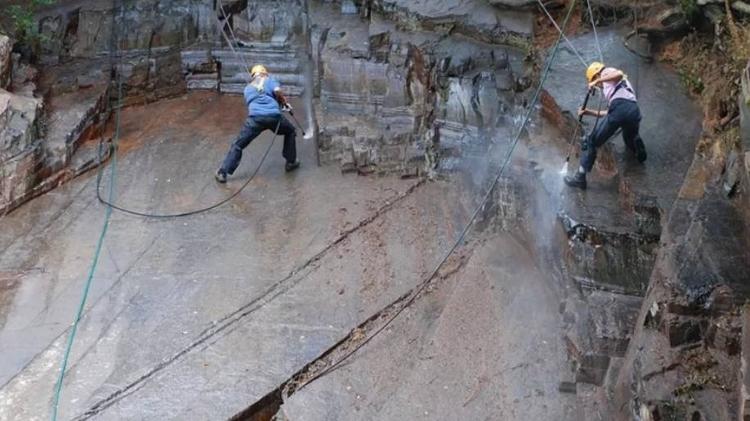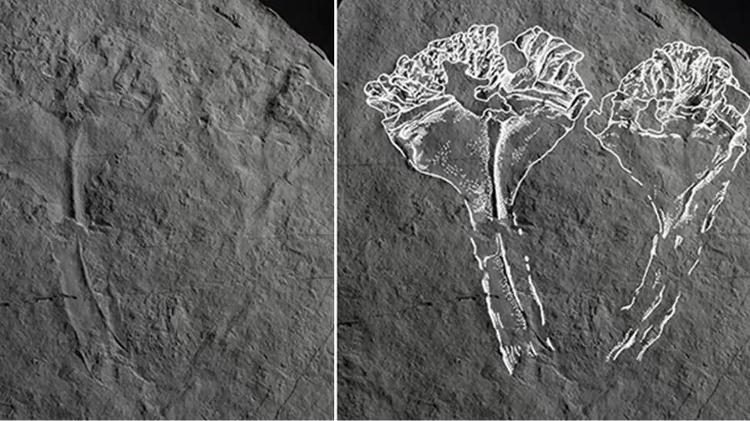The fossil of the oldest known predator has been identified by British scientists.
The 560-million-year-old specimen, found in Leicestershire’s Charnwood Forest, may be a precursor to cnidarians, the group of animals that today includes jellyfish.
Researchers named Auroralumina attenboroughii for the fossil. This is a tribute to the naturalist David Attenborough, the BBC’s historical presenter.
The first part of the name is a reference to a Latin expression meaning “dawn lantern”.
“I think it looks like an Olympic torch with tentacles of flame,” says Frankie Dunn of the University of Oxford, who wrote a paper about the discovery in the journal Nature Ecology and Evolution.
Not only does the fossil provide evidence of predators in the animal kingdom about 20 million years earlier than previously thought, but it’s also likely to be the first example of such an organism with a true skeleton.
The outline of the 20-centimetre-long creature sat on a long, sloping quarry slab surrounded by other fossils.
They are all believed to have been buried by a stream of sediment and ash flowing down the undersea flank of an ancient volcano.
The area where the fossils were found was discovered in 2007 when researchers cleaned the rock surface of Charnwood with high-pressure hoses.
It took them 15 years to figure out the location, but that’s when they found exactly where it was. Auroralalumina.
The Leicestershire region is famous for what it tells us about the period known as the Ediacaran (635 to 538 million years ago).
This is the period of geological history that preceded the Cambrian, which saw a massive explosion in the number and diversity of life forms on Earth.
The “model” for many modern animal groups was set in the Cambrian (538 to 485 million years ago).
But the Auroralumina proves that its own grouping, the cnidarians, has a heritage that goes all the way back to the Ediacaran.
“It’s a strong sign that there were more modern-looking organisms in the Precambrian. This means that the wick of the Cambrian explosion was probably quite long,” explains Phil Wilby, head of paleontology at the British Geological Survey.
While the name “cnidaria” might not sound that familiar, the animals that fall into this category are quite familiar: corals, jellyfish, and anemones. Another feature is the stinging cells they use to catch their prey.
Dunn’s analysis of his traits Auroralalumina links the animal to the medusozoa subgroup within the cnidarians.
Meduzozoans go through several stages during their complex life cycle. In one, they look like a mass anchored to the bottom of the sea. Later in the breeding season, they turn into floating creatures.
During this floating stage, they take on an umbrella shape with biting tentacles. They become a kind of jellyfish.
Auroralumina is therefore more similar to a medusozoan in its dormant, rooted stage.
missing discovery
“What’s really interesting is that the animal was bifurcated. So there are these two ‘cadders’ stuck near its bottom, and there was a continuous piece of skeleton that went down to the seafloor, but we couldn’t find that piece. Unfortunately, the fossil is missing,” Dunn said.
Bifurcation, that is, splitting into two branches or fragments, is another novelty in the newly found fossil.
Paleontologists from all over the world visit Charnwood Forest.
It is the fossil known as the main attraction. charnia mason.
It was found in the 1950s by two students, Roger Mason and Tina Negus, and was the first Precambrian fossil to come to light.
this charnia It was also found in the rocks that later formed the Ediacaran Hills in Australia and gave its name to the Ediacaran period.
It has a strange-looking life form resembling a fern leaf, but scientists are convinced it really is some kind of animal.
there is also an example Auroralalumina only 40 centimeters in the same place.
The name David Attenborough was used to name the animal as it grew up in this central part of England.
“I was an avid fossil hunter when I was at school in Leicester,” he recalled.
“The rocks standing on Auroralalumina What has been discovered is considered to be so ancient that they date back to long before the beginning of life on the planet. That’s why I never looked for fossils there,” he said.
“A few years later, a kid from my old school found a fossil and proved the experts wrong. He got the award: his name was used to name the find. Now I almost got it and I’m really happy,” says Attenborough.
– This text was published at https://www.bbc.com/portuguese/geral-62300687.
source: Noticias
[author_name]


